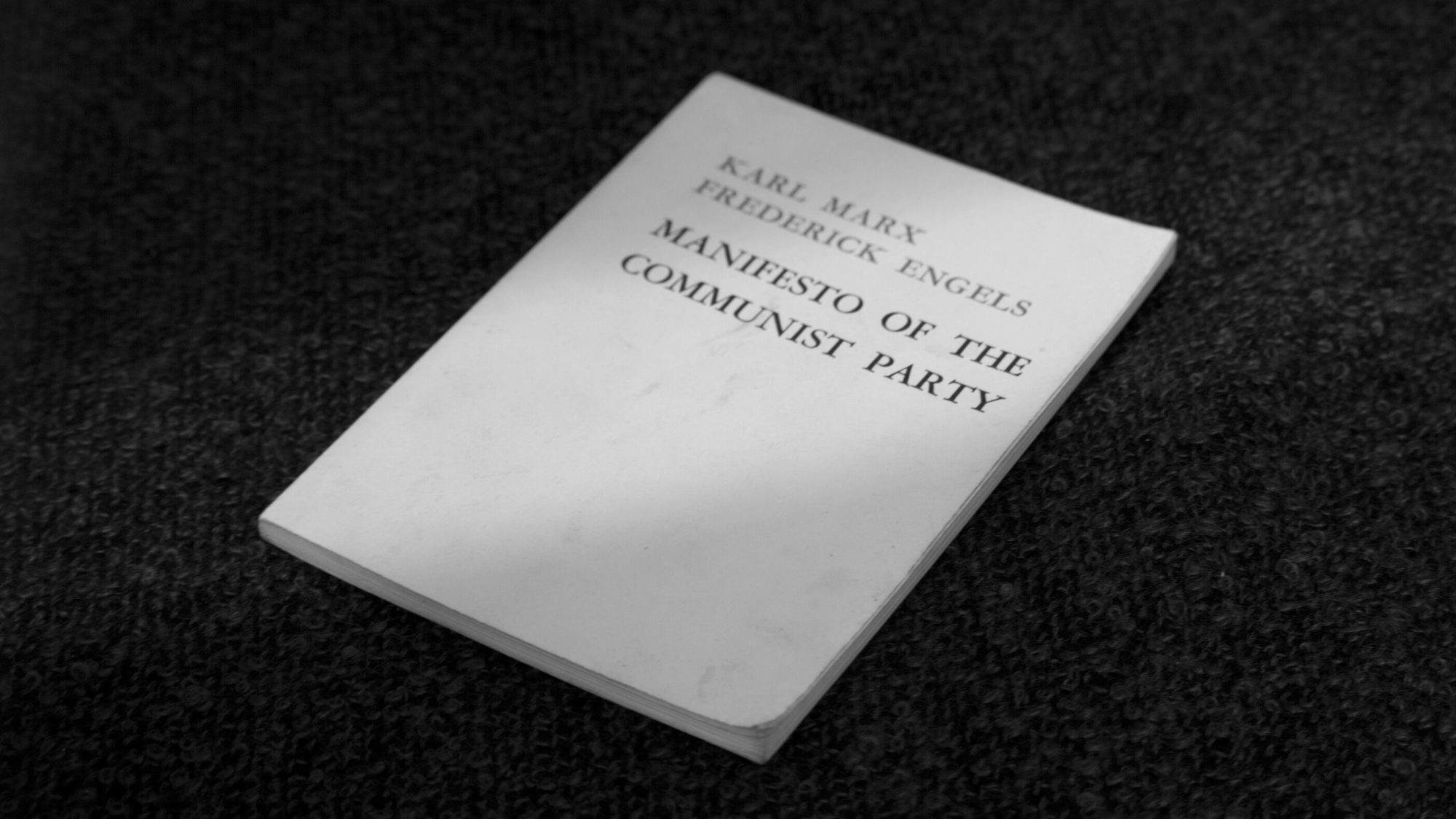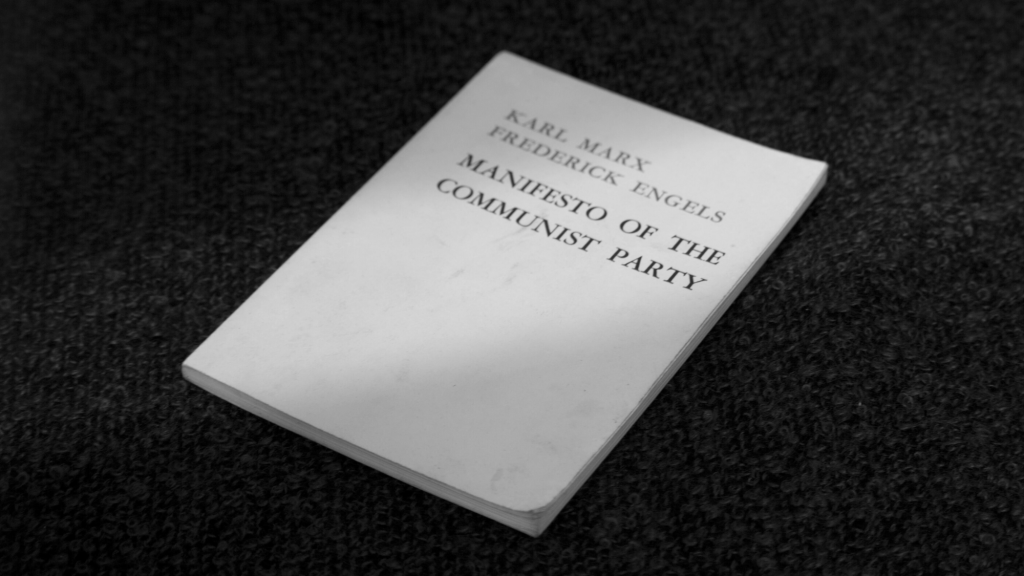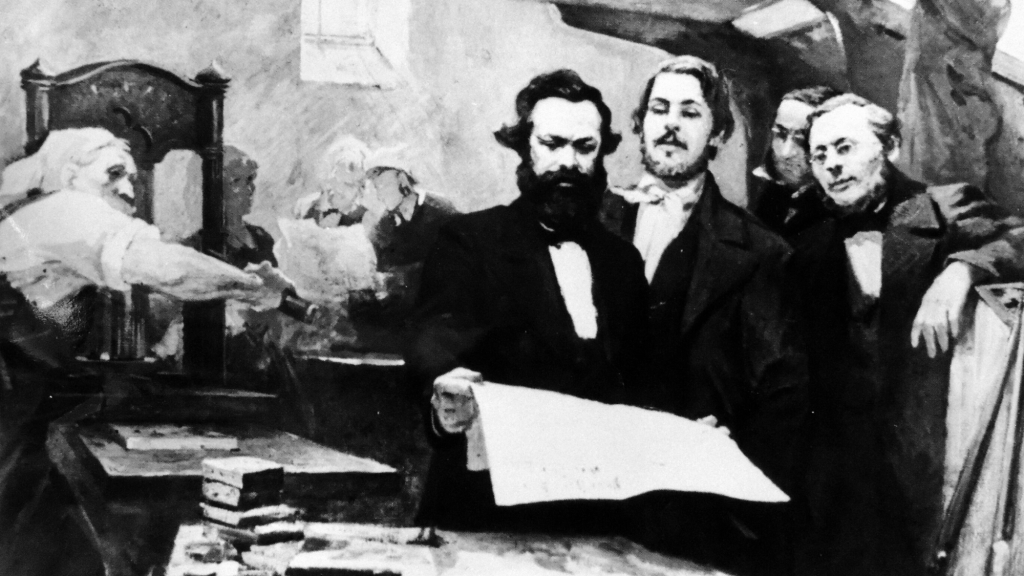The Birth of the Communist Manifesto

February 2023 marks the 175th Anniversary of The Communist Manifesto. The pamphlet was originally published on 21 February 1848 by Karl Marx and Friedrich Engels. What did it say? How did the Manifesto impact the last two centuries of human history? What is its enduring legacy, and did the Manifesto deliver what the authors promised?

Marx and Engels published their Communist Manifesto as the official programmatic statement of the Communist Party—or Communist League, as it was then called. The Communist League was a small group of almost exclusively white European men, mostly German. Its members knew they needed a statement of what they as communists envisioned. That is what the Communist Manifesto really was, namely: a manifesto for a movement which, at that point, had lacked a single written statement laying out communist beliefs.
Marx and Engels viewed the initial draft of their manifesto as a revolutionary “catechism” for an awaiting world. They saw it and referred to it, certainly in the initial draft stage, as a literal Communist Confession of Faith, before opting for the title that stuck. “Think over the Confession of Faith a bit,” Engels wrote to Marx in November 1847. “I believe we had better drop the catechism form and call the thing: Communist Manifesto.”[1]
Even then, the document was, for these proud atheists, very much a catechetical confession of faith. Their communism became their religion, even as they scoffed at religion as something for superstitious idiots. Truly, their manifesto was and became their bible.
And hence, these communists’ confession of faith became the one and only Communist Manifesto.
Notably, usage of the word “communism” preceded the Communist Manifesto, as Marx and Engels were able to refer to it in the book as something that already existed and was known to certain people. It is possible that they coined the term themselves in Paris a few years before the publication of their Manifesto, but pinning that down is elusive; they certainly, however, popularized the term. Quite fittingly, Marx and Engels met in August 1844 in Paris, where Marx a year earlier had already moved with his wife and begun studying the French Revolution, various utopian socialists, and attending workers’ meetings and engaging in other leftist activities.[2]
Marx envisioned an apocalyptic revolution leading to the overthrow of capitalism by the impoverished working class, the common people, the masses—the so-called “proletariat.” The stage in the revolutionary process immediately following this overthrow would be that of the Dictatorship of the Proletariat. That “dictatorship” would be a waystation on the road to the ultimate utopian goal of a “classless society.” The state in the process would be abolished; it would die out; it would “wither away.” With a classless society, class antagonisms would hence disappear, as would conflict (including armed conflict), as would economic inequality, as would social inequality, and peace and harmony would follow. Society would evolve through dialectical stages: from feudalism to capitalism to socialism to communism. Communism was the apotheosis.
Getting there, Marx and Engels insisted, meant that socialism would need to sweep the planet. It had to be worldwide. That was the plan, and that is no small thing. Nonetheless, Marx and Engels, and then Lenin and Stalin and a train of others, felt it could happen. It was the ultimate utopian pipedream.

And yet, the plan was not so dreamy as to lack specificity. To the contrary, Marx and Engel had a 10-point plan. Here it is, taken verbatim from their manifesto:
1. Abolition of property in land and application of all rents of land to public purposes.
2. A heavy progressive or graduated income tax.
3. Abolition of all right of inheritance.
4. Confiscation of all property of emigrants and rebels.
5. Centralization of credit in the hands of the state, by means of a national bank with state capital and an exclusive monopoly.
6. Centralization of the means of communication and transport in the hands of the state.
7. Extension of factories and instruments of production owned by the state; the bringing into cultivation of waste lands, and the improvement of the soil generally in accordance with a common plan.
8. Equal obligation of all to work….
9. … gradual abolition of all the distinction between town and country by a more equitable distribution of the population over the country.
10. Free education for all children in public schools….
Marx and Engels demanded that such a 10-point program be implemented not merely in one nation but throughout all nations of the world. Many subsequent socialists, beginning with Vladimir Lenin and his Bolsheviks in 1917, worked from that blueprint.
Of course, Marx and Lenin and their disciples knew that force would be necessary to implement such a truly radical, totalitarian ideology. After all, their philosophy demanded an unequivocal rejection of most basic rights, including property. Stated Marx: “the theory of the Communists may be summed up in the single sentence: Abolition of private property.”
Many Marxists and socialists and “democratic socialists” today fuss over to what degree Marx wanted to remove or limit property, but in the Manifesto he (and Engels) doubled down. “You are horrified at our intending to do away with private property,” they wrote. “But in your existing society, private property is already done away with for nine-tenths of the population.” And then this: “In one word, you reproach us with intending to do away with your property. Precisely so; that is just what we intend.”
That was truly revolutionary. The rejection of such a natural if not sacred right of property violates the most basic precepts of all peoples, from the cave to the courthouse, from Judeo-Christian thinking to the most innate urges of primitive tribes. The Old Testament commandment, Thou shalt not steal, implies a right to property. Marx was not oblivious to just how radical his vision was. He himself acknowledged that his views stood undeniably contrary to the “social and political order of things.” Communism, he and Engels wrote in their Manifesto, not only seeks to “abolish the present state of things” but represents “the most radical rupture in traditional relations.” They knew what they were advocating; this was a revolution, touching on everything from property to the family. “Abolition of the family!” they wrote with an exclamation. “Even the most radical flare up at this infamous proposal of the communists.”
Again, look at just a few of the specific policy recommendations in the 10-point plan of the Manifesto. Equally telling, look at how Marx and Engels prefaced the 10 points: They stated of their 10 points: “Of course, in the beginning, this cannot be effected except by means of despotic inroads.” Marx and Engels willingly conceded that this program would require despotism.
Of course, it would. Human beings would not give up such fundamental liberties without resistance. Seizing property alone would require a terrible fight, prompting implementers to use their guns and gulags. This is a vision that necessitates prison camps. Force requires force.
Lenin, Trotsky, Stalin, and a long line of implementers candidly admitted that force and violence would be necessary. In the close of the Manifesto, Marx and Engels stated emphatically: “The Communists … openly declare that their ends can be attained only by the forcible overthrow of all existing social conditions” (italics added).
In practice, obviously, “forcible overthrow” meant bloodshed.
What level of bloodshed? Communism was implemented by the Bolsheviks in Russia in their revolution of 1917. From there, it eventually spread by force to Eastern Europe after World War II, to China, North Korea, Vietnam, Cambodia, elsewhere in Asia and Europe, and to spots in Latin America and Africa.
Communism’s most successful form of redistribution was not wealth, which the ridiculous system fails to produce, but government-orchestrated crime. Everything was so nationalized and so centralized that it was as if the government seized crime, too.
Communism committed a “multitude of crimes not only against individual human beings but also against world civilization and national cultures,” wrote Stephane Courtois, editor of the classic Harvard University Press work, The Black Book of Communism. “Communist regimes turned mass crime into a full-blown system of government.”[3]
Under communism, there was no profession of self-evident, inherent “unalienable” rights; that is, absolute rights endowed by the Creator to humans to begin with, and thus protected by a just government. Governments were not “instituted among men” to help secure such rights, as Thomas Jefferson put it. No, communist governments took away those rights.
“Communist regimes did not just commit criminal acts,” observed Martin Malia, a Harvard Ph.D. and professor at the University of California-Berkeley, who wrote the preface to the Penguin classics edition of the Manifesto in 1998. Malia noted that there have been non-communist states that likewise committed criminal acts. But communist regimes, noted Malia, “were criminal enterprises in their very essence: on principle, so to speak, they all ruled lawlessly, by violence, and without regard for human life.”[4]
The communist culture of death has been prolific. Whether by bullet, by starvation, by exposure to the elements, by war and terror against internal citizens and “enemies” of the state, or by whatever means.
In 1999, The Black Book of Communism endeavored to attempt the impossible task of tabulating a Marxist-Leninist death toll in the 20th century. It came up with a figure approaching 100 million.[5] Here is the breakdown:
- U.S.S.R.: 20 million deaths
- China: 65 million deaths
- Vietnam: 1 million deaths
- North Korea: 2 million deaths
- Cambodia: 2 million deaths
- Eastern Europe: 1 million deaths
- Latin America: 150,000 deaths
- Africa: 1.7 million deaths
- Afghanistan: 1.5 million deaths
- The international communist movement and Communist parties not in power: about 10,000 deaths
The Victims of Communism Memorial Foundation likewise cites the figure of 100 million deaths. Dr. Malia aptly notes that the communist record offers the “most colossal case of political carnage in history.”[6]
And even then, these frightening numbers are quite conservative.
Take the figure relating to the Soviet Union, where the Black Book recorded merely 20 million dead.[7] Alexander Yakovlev, a high-level Soviet official who became one of Mikhail Gorbachev’s chief reformers, and who, in the 1990s, was given the official task of trying to add up the victims, estimates that Stalin alone “annihilated … sixty to seventy million people.” His figures are consistent with those long estimated by the likes of Nobel dissident Alexander Solzhenitsyn, among others.[8]
Likewise, the latest biographical-historical research on Mao Zedong’s communist China suggests as high as 70 million deaths.[9] And communist crimes continue to pile up in countries like North Korea and Cuba.[10] Really, the death generated by communist governments in the 20th century, and, primarily, in a more concentrated period from roughly 1917-1979, is far higher than 100 million.
That is communism’s dominant legacy.
Sadly, the “specter of communism,” as Marx and Engels described it in the opening line of their Manifesto, is not finished sweeping through history. That means that many more victims are still to come.
Dr. Paul Kengor is a member of the Academic Council of the Victims of Communism Memorial Foundation, professor of political science at Grove City College in Grove City, Pennsylvania, and a New York Times bestselling author of nearly 20 books.
[1] Engels letter to Marx dated November 23-24, 1847, posted at: https://www.marxists.org/archive/marx/works/1847/11/prin-com.htm.
[2] Among other sources, the authoritative www.marxists.org historical archive states that on August 28, 1844 “Marx and Engels meet in Paris; this is the beginning of a lifelong friendship and joint work.” https://www.marxists.org/archive/marx/bio/marx/lifeandwork.htm.
[3] Stephane Courtois et al, The Black Book of Communism (Harvard University Press, 1999), pp. 3-4.
[4] Malia in Courtois, Black Book, pp. xvii-xviii.
[5] Courtois, Black Book, p. 4. Some contributors to the book, namely, Nicolas Werth and Jean-Louis Margolin, disassociated themselves with the number 100 million, claiming that it was approximated and not completely accurate. See: Ron Radosh, “The Black Book of Communism: Crimes, Terror, and Repression,” First Things, February 2000. Also see: Robert Stacy McCain, “Communism’s Atrocities Detailed in ‘Black Book,’” Washington Times, September 21, 2000.
[6] Malia in Courtois, Black Book, p. x.
[7] Courtois, Black Book, p. 4.
[8] See: Alexander Yakovlev, A Century of Violence in Soviet Russia (New Haven, Conn.: Yale University Press, 2002), p. 32; Alexander Solzhenitsyn, Alexander Solzhenitsyn Speaks to the West (London: The Bodley Head, 1978), p. 17; and Lee Edwards, editor, The Collapse of Communism (Stanford, CA: Hoover Institution Press, 1999), p. xiii. Edwards cites figures by political scientist R. J. Rummel, who draws on the research of Solzhenitsyn, Robert Conquest, and others, thereby estimating that the USSR was responsible for the death of 61.9 million from 1917-87.
[9] The latest figures of 70-million plus by Mao are recorded in the seminal work, by Jung Chang and Jon Halliday, Mao: The Unknown Story (New York: Knopf, 2005). On Mao, the Black Book records 65 million dead (page 4).
[10] See my discussion in the North Korea section of Paul Kengor, The Politically Incorrect Guide to Communism (Washington, DC: Regnery, 2017).

